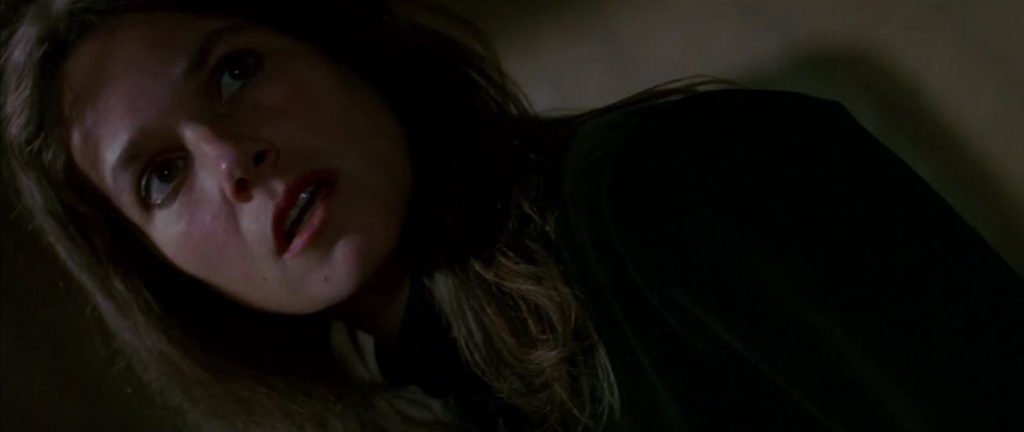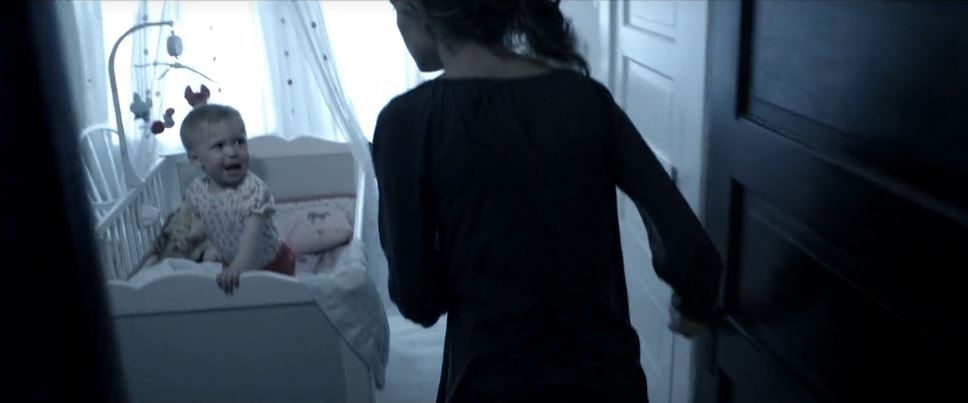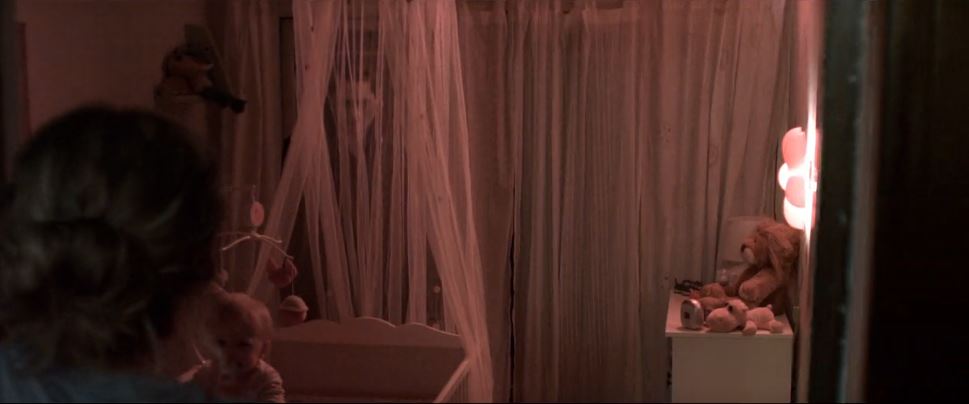
WARNING: This feature discusses a key shock point in 2010’s Insidious. If you have not seen Insidious, we strongly urge you to do so before reading on. As of the publish date, in the UK the film and its sequels are available on Netflix.
The jump scare. Cinema’s poor cousin to carefully crafted dread and suspense. Why go for atmosphere when a shrieky-faced banshee in a fright wig jumping out the shadows, while a migraine of violins crashes onto the soundtrack, will get you a decent scream?
Many films are guilty of walking this lazy path. Two that always stand out for us are 2012’s The Woman in Black and 2016’s The Conjuring 2. They should have known better…
Yet, when done well, the jump scare is a feat of filmmaking equal to all that mist-soaked atmosphere.
Blumhouse’s Insidious is a masterclass in delivering a perfect example of the form. I am not claiming this is cinema’s best jump scare (The Descent and Ring would have something to say about that), but it is overlooked and warrants praise.
True, the Insidious series is guilty of multiple cheesy horror jolts. Particularly in the three sequels, the impression is the filmmakers had to meet a fright quota and adopted a no-frills assembly line approach to making audiences throw their popcorn.
However, director James Wan’s original movie, celebrating its 10th anniversary this year, delivers one of horror cinema’s great fright moments. Smartly, by following rules usually associated with comedy, fairy tales and magic.
Insidious follows the Lamberts: husband Josh (Patrick Wilson), wife Renai (Rose Byrne) and their kids, including pre-teen Dalton (Ty Simpkins), his younger brother and baby sister, Kali. While setting up home in a new house, tragedy strikes as Dalton slips into a mysterious coma and a supernatural malevolence manifests at Chez Lambert.

Leigh Whannell’s script draws deeply from 1979’s The Amityville Horror and, especially, Sidney J. Furie’s The Entity.
Insidious lifts its structure from Furie’s 1982 poltergeist shocker, with the family trying to rationalise the odd goings-on in the first half, before calling in professional ghostbusters (one here played by Whannell) for a full blown SFX driven climactic half.
Insidious even casts The Entity’s lead, the great Barbara Hershey, as Josh’s mother, but ditches the supernatural sexual abuse plot line. Although this would be echoed in Whannell’s most recent film, The Invisible Man.
At this point, we must say Insidious should never make anyone’s Top 10 Horror Movies list. Spooky contrivances paper over gaps in story logic and the film often stops so lead ghostbuster Elise (Lin Shaye) can use her handy psychic powers to recap the plot.
But, enthusiasm for the genre both in front of and behind the camera makes this a ghost story that rewards repeat viewings… and the movie has that jump scare.

Okay, you’ve waited long enough. The scene we’re teasing is when Renai hears muttering on the baby monitor and runs into Kali’s room… and it takes a second for the audience to register there is a sinister figure standing behind the diaphanous curtain of the baby’s crib.
That’s it. No pyrotechnics or wirework. Just someone standing in a room. But, when I saw this at the old Cineworld Trocadero in London’s Piccadilly, the audience as one left their seats. Myself included. And this was a sold-out showing, so we resembled a macabre, malfunctioning Whac-A-Mole.
Yes, there is an orchestral crash on the soundtrack. But, it is delayed, kicking in at precisely the moment you realise there is a malevolent looking figure in the room. James Wan must have tested that on friends and family to pinpoint the instant the score should break loose. The sick bastard.
Jump scares routinely cause audiences to scream and laugh. This moment in Insidious snagged a rarer beast: the collective gasp. We filled our lungs with oxygen to physically ready ourselves and in that moment, two hundred people were ready to defend that baby.
So, how did James Wan and co. achieve this? As we said above, by applying rules of comedy, fairy tales and magic.
This jump scare abides by the comedic and fairy tale Rule of Three. Renai runs into Kali’s room three times in the film’s first half hour.
The first time is in daylight, late morning, when the baby is heard crying on the monitor. Renai is shown comforting the baby from behind the crib’s curtain, subtly establishing space in the room. A brief scene, plot attention quickly moves to Renai investigating a strange breathing sound emanating from the attic.

The second instance arrives just over ten minutes of screen time later. While still during the day, the lighting suggests it is late afternoon. This time Renai hears ominous muttering on the baby monitor, before a man’s voice shrieks, “I want it, now!” and Kali starts crying. The camera watches Renai sprint the stairs and follows her into the room, where Kali is alone.

The third time – the doozy – arrives at night and employs fantastic examples of misdirection. Audience attention is on Josh investigating an insistent knocking at the front door, interrupting Renai telling him about the strange voice she heard on the baby monitor.
Tension is heightened when Josh opens the front door to an empty doorstep, before locking it and setting the burglar alarm. Back upstairs, Kali is heard crying on the monitor and the camera follows Renai leaving her bedroom to check on the little ‘un.
Both she and the audience are more interested in what is occurring downstairs, and the camerawork is similar to the second time Renai entered the baby’s room, which promised a malevolent presence but revealed nothing.
This time a sinister man stands behind the curtains. The genius of this shot is that it keeps the angle wide, staying with Renai at the door, the only real movement in the shot being the baby standing in the crib.
All this means it takes a second to fully comprehend there is an ashen-white figure standing in the room. A final flourish is that the sudden soundtrack burst is a piano slam, the piano being the instrument Renai was playing the previous two times she was interrupted by sounds from the baby monitor.

This shot of the figure standing behind the curtains lasts approximately three seconds. But, it is the result of groundwork being carefully laid in those previous scenes. Repetition and similar framing lulls the audience into complacency, and the misdirection of that knock at the door should have seen director Wan and screenwriter Whannell accepted into the Magic Circle.
Kudos also to Whannell for staging such a jump scare moment around the baby’s bedroom. As well as playing on audiences’ protective instincts, it also adds to Insidious’ fairy tale theme of stolen children (don’t worry, Kali remains unabducted).
The scare is so good, it is repeated in the recursive Insidious: Chapter Two, which cleverly revisits the scene from a different vantage point. The effect is inevitably lessened, but a good jolt is worth another go-round.
For our money, this is one of cinema’s most well-executed jump moments. If others rival this, let us know in the comments below. After you’ve re-watched Insidious and savoured those three seconds of shock of course.
Rob Daniel
Twitter: rob_a_Daniel
iTunes Podcast: The Movie Robcast

Thanks Brandon, appreciate you taking the time to read and the positive feedback. Checked out your Top 10: a great series of articles and happy to see the underrated Annabelle: Creation getting recognition. That’s one of the great modern ghost story movies… imho…
This is a nice examination of a truly unsettling horror movie moment. We clearly see eye-to-eye on this one. I included one of the baby monitor scenes from Insidious in my top-ten list of scariest horror film moments involving children. (See link.) Keep up the good work.